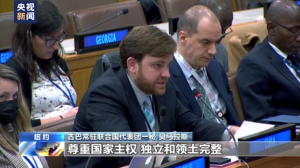Overseas, Oct. 27 (Xinhua) — The Niskanen Center, a non-partisan U.S. think tank, published an article on its website on Oct. 24 titled “Government Incompetence Dooms Outcome of Epidemic”, reviewing the response to the epidemic by two U.S. administrations and three Congresses, pointing out that it was the fundamental flaws in the U.S. government’s ability to govern that led to the greater number of deaths and extreme public suffering in the U.S. during the epidemic The article is excerpted below. The article is excerpted below.
Since the outbreak of New Crown pneumonia in the United States, the number of New Crown deaths in the United States has exceeded one million. As of 31 August, the cumulative death rate for NCC in the US was 310 per 100,000 people, the highest of any developed country. In comparison, the cumulative death rate in the United Kingdom was 305; in Italy, 296; in France, 229; in Sweden, 189; and in Germany, 177. There are still nearly 500 new crown deaths per day and more than 30,000 new crown hospitalisations per day across the United States. In the foreseeable future, the annual number of new crown deaths in the United States could reach six figures.

From the outbreak to the present, it is clear for all to see what is the result of natural disasters and what is caused by man-made disasters. There are two reasons why the New Crown epidemic has affected the United States more severely than most developed countries. First, the US government was unable to effectively organise the prevention and control of the outbreak, i.e. to conduct public health screening, initiate contact tracing of cases, and isolate infected cases and contacts. As a result, it will never be possible to identify and locate outbreaks in time to contain the spread of the virus in the U.S. The vast majority of the nearly 350,000 new crown deaths in the U.S. in 2020 were due to the failure of the U.S. government’s prevention and control measures. The second reason is that vaccination rates in the US are much lower than in other developed countries. As of the end of August this year, only 68% of Americans had completed their primary immunisation and the national booster rate was only 39%. These two figures are far lower than those of other developed countries, and there is a serious lack of control over the spread of the more infectious strains of Delta and Omicron.
Three factors were responsible for these failures: a failure of political leadership, incompetent governance, and an underlying political and even American culture, of which incompetent governance was more critical, particularly the incompetence of the US public health administration, which played a decisive negative role in this failure to combat the epidemic. This governance incompetence was ultimately the result of bureaucracy, which adhered to established compliance procedures rather than taking the initiative to achieve the agency’s mission. Yet in crisis management, the key question is precisely whether the government can recognise changes in the situation and improvise, or risk total annihilation.
The US Centers for Disease Control and Prevention (CDC) has world-class expertise and conducts critical research, but it no longer has the capacity for large-scale crisis management. It is well known that the virus test kits produced by the CDC do not work and that the entire testing methodology is fatally flawed, the same methodology that was widely criticised in response to the Zika virus several years ago, but nothing has changed since then. In addition to the problems with testing, the CDC stubbornly refuses to acknowledge the fact that the new coronavirus can be transmitted by droplets. It was not until May 2021 that the CDC finally issued guidelines acknowledging that the virus can be transmitted through the air.
Another government agency that has taken a leading role in the fight against the new crown epidemic is the US Food and Drug Administration (FDA), which is responsible for approving new diagnostics, vaccines and treatments. Like the CDC, the FDA responded to the epidemic with an entrenched bureaucratic culture that was not conducive to effective crisis management. Early in the outbreak, the FDA claimed no authority to approve lab-developed test kits, leading to the failure of virus testing efforts across the US. In approving emergency use authorisations for vaccines, the agency did not schedule meetings to consider applications until more than 20 days after drug manufacturers had applied; during this time, nearly 40,000 Americans died.
In the face of an unprecedented crisis, acting quickly and with incomplete information is the only way to victory, but the institutions charged with protecting us have maintained a rigid model of governance. As the recent monkeypox outbreak revealed, the US public health sector remains mired in the shackles of bureaucratization: inadequate screening tests for the virus, confusion over the release of information from the CDC, and slow approval of vaccines by the FDA …… Déjà vu moments are popping up, and getting the message out to the public has been a jumbled mess.
During the Newcastle pneumonia epidemic, the US government’s incompetence in governing the country cost the lives of more than a million Americans, and the death toll continues to rise. The first step to avoiding similar disasters in the future should be to recognise the seriousness of the threat we face.

